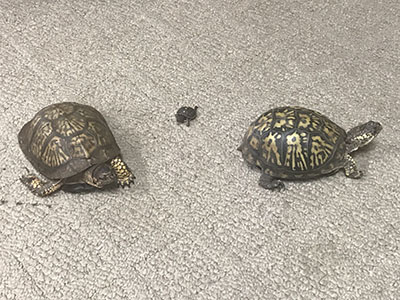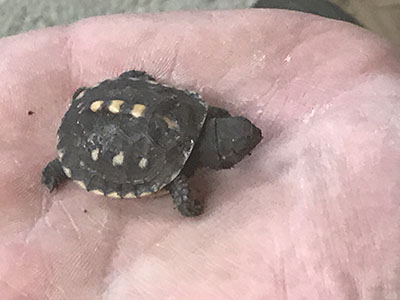A Turtle Tale: Whitehouse Nature Center’s Newest Addition Is Unexpected, Welcome
Related Posts
Connect With Us
May 28, 2020
By Chuck Carlson

Whitehouse Nature Center Eastern box turtles Sid (left) and Nancy (right) with their to-be-named hatchling.
To all those who know them, Sid and Nancy have had what could charitably be called a difficult relationship.
Sid, short for Darth Sidious of Star Wars fame because of his blazing eyes, wants more from his partner, Nancy, than she is sometimes willing to give.
That has led to some unpleasant encounters between the two, including Sid’s constant nipping at Nancy’s legs in what he views as amorous advances but which Nancy views as simply annoying.
“The nature assistants and I nicknamed their habitat the Playboy Mansion after the well-known residence of Hugh Hefner as a reminder to check the habitat before showing it to school kids,” said Jason Raddatz, ’91, director of Albion College’s Whitehouse Nature Center. “But we had to separate her from Sid because he was after her the whole time to make babies. It’s impressive when you consider he’s like 90 years old. He’s getting up there. And Nancy is about 60. But all that Sid wants to do is eat and make babies.”
Oh, by the way, Sid and Nancy are Eastern box turtles, longtime residents of the Nature Center, and while their relationship has often been turbulent, it has also been, well, productive.
In February, for the second time in three years, Nancy dropped eggs, and while the first batch two years ago produced no offspring, of the six she laid this year, four survived and one has produced a hatchling.
Raddatz presumes the baby, which hatched in March, is a female. Today it’s still no bigger than a golf ball, but the mere presence of the newborn is impressive.
“This is kind of a big deal,” said Raddatz, who said Eastern box turtles do not often produce hatchlings outside their native wild habitat, which is usually no bigger than an acre “They’re considered a species of special concern, which is one maybe two steps from endangered. There’s maybe a five percent success rate in getting them to reproduce.”
The hatchling caused a stir among the Albion students who have worked at the Nature Center in roles that have ranged from maintaining trails to working at the student farm.

It could take up to 10 years for this new Whitehouse Nature Center resident to reach full size, Center Director Jason Raddatz said.
Indeed, the new addition was made possible when student and volunteer Alexa Alley, ‘21, brought in an incubator and students also constantly monitored the eggs, making sure the temperature in the incubator was kept at 87 degrees. That’s about the only evidence Raddatz has right now that the little turtle is female, since a hotter temperature in incubation usually means a female will develop while a temperature under 80 degrees often leads to males, which have a tendency to be more aggressive.
As well, students kept an eye on the eggs has much as possible to make sure they had a chance to survive since because if the eggs remained with Nancy, she might have eaten them, Raddatz said.
And though the students were not on campus when the eggs hatched (they had been sent home due to the COVID-19 pandemic), they kept in contact on what was happening.
“This is a really big deal,” said Kierra Bush, ‘20, an English major from Grand Haven who worked at the Center for a year and a half before graduating this spring. “Turtles can be fertile up to seven years after they mate and there had been no eggs for a long time, so we were surprised when we saw eggs in her habitat.”
There are still two eggs in the incubator that could hatch at the end of June or early July but the only way to know is to see if the eggs are “candling,” which means holding the eggs up to the light to see veins and an embryo forming inside.
For Raddatz, who took over as director last year, this new addition is another opportunity to promote the Center, especially to local schoolchildren, who he hopes to include in a name-the-turtle contest for the as-yet-unnamed little one.
He said he’d like the hatchling to grow larger (it can take 10 years for them to reach full size) before any decisions are made about its future and whether to release it into the wild. In the meantime, he will include it as part of the traveling exhibit to local schools, which also includes Sid, Nancy and a third adult female turtle. Elvira.
“They’re very docile and easy to handle,” Bush said. “They’re really fun creatures and kids love to hold them.”
The hatchling, which can live to be 120, has its own habitat at the center but, sadly, Sid and Nancy must live apart since they are unable to bridge that gap of misunderstanding that seems to afflict so many couples today.
Indeed, when Sid and Nancy were placed in the Center’s main floor along with their baby recently, Sid again went right for Nancy while she calmly headed in the other direction.
Raddatz smiled.
“You know what he wants,” he said.